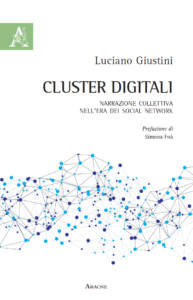
Link rapidi Info
Questa sezione presenta una raccolta di puntatori ad articoli scientifici, dedicata in particolare alla disinformazione, alle fake news e fact-checking in ambito web e social. Le sezioni “data” e “tools” sono dedicate alle ricerche che implicano dati e agli strumenti pratici per attuarle.
▶️ ComLab. Info sul Laboratorio in Comunicazione e Digital Media (Sito Web) – Università degli studi di Roma Tor Vergata.
▶️ Cluster Digitali. Il sito per il libro di testo (con informazioni sulle versioni disponibili), la monografia del corso sugli argomenti della disinformazione, fake news, filter bubble e cluster narrativi digitali.
▶️ Scientific Literature. Lettura obbligatoria per gli studenti del ComLab. Reading sequence of scientific papers from the italian Data Science and Complexity Lab researchers. For the ComLab’s students: mandatory selected scientific papers.
▶️ Rassegna Stampa. Un elenco ragionato di articoli di interesse, retrospettive e contributi sui temi trattati nei corsi o a lezione.
Risorse e siti web sulla disinformazione
In inglese
▶ Poynter.org‘s IFCN (also manages: Politifact | TW: International Fact-Checking Network)
▶ Snopes.com
▶ Media Bias Fact Check (affidabili|non affidabili e non vero/falso)
▶ First Draft
▶ Reuters Fact checking
▶ ICIJ Internationl Consortium of Investigative Journalism
▶ @EUvsDISINFO ( European Union East Stratcom Task Force)
▶ FactCheck.org
▶ Bellingcat.com (investigative journalism)
▶ ProPublica (investigative journalism)
▶ AVAAZ Disinformation Reports Hub
▶ The Markup | BlackLight (privacy report)
In italiano
▶ IDMO – Italian digital media observatory 🆕
▶ Butac | pagina FB
▶ Bufale.net | pagina FB
▶ Valigia Blu | pagina FB (Manuale di Sopravvivenza alle Breaking News)
▶ Disinformatico | profilo TW; (sulle foto false)
▶ @FactaNews | Sito Web
▶ @LaVoceinfo | Sito Web
▶ @PagellaPolitica | Sito Web
▶ Open – Fact-checking
▶ Smask.online (profilo IG)
Guide e manuali
🔸The Debunking Handbook 2020: Downloads and Translations (new version)
🔸What does it take to change a mind? | TEDxSydney (Lucinda Beaman, Fact Check editor The Conversation, 2018)
🔸«Questo chi lo dice? E perché?» Come riconoscere e smontare le bufale storiche (Collettivo Nicoletta Bourbaki, WuMing, 2018)
🔸Facile dire fake news. Guida alla disinformazione di Valigia Blu (2017)
🔸Bugie, bugie virali e giornalismo (PDF) (da Il Post, 2015)
🔸Guida alla verifica di foto e video sui Social media di France24 (tradotta in italiano da ValigiaBlu), 2015
🔸Verification Handbook (versione italiana) di Craig Silverman, 2014
🔸Manuale della demistificazione (a cura di John Cook e Steve Lewandowsky, 2012)
Social
Profilo del Laboratorio: www.instagram.com/com.lab
Creato nel 2020, fornisce contenuti aggiuntivi rispetto al corso, in parte di tipo didattico, e ospita alcuni contributi degli studenti con video, reel, stories e caroselli. Può essere utile anche per verificare le fonti e dare un’occhiata ai following
Twitter/X
Profilo del Laboratorio: X.com/@ComLABX
Twitter is a microblogging social network; from Nov. 2017 has 280 characters. Twitter/X tracks users’ behaviour outside the app (f: Telegraph), check “Settings and privacy”, “Your account data” and other sections like twitter.com/personalization. From 2023 has been bought by Elon Musk who renamed it as X.com, adding extended features by subscription; also the algorithm changes, and the whole platform becomes less moderated. The Twitter verification program, in addition to the previous automatic blue sticker for verified individuals, organizations and institutions, changed in “Twitter Blue”, a variety of stickers (in different colours) upon payment of a annual fee. Thus was introduced a generalized payment in several levels for individuals and organizations and/or commercial brands.
Various Notes (Warning: some may vary). To see what Twitter thinks your interests are, click on the number of “Interest from Twitter” and it will show you the full list. This section is extensive, but also somewhat vague. To see rhat its partners think about you: Tap on the number of “Interests from partners” and it will show you them. To see the companies targeting you: under “Tailored audiences” the social network shows you how many audiences you are part of and how many advertisers are interested in you.
Other resources
- The Guardian Long Reads (Twitter)
- Apply magic sauce: Psychometrics Personality Test, Strategic Research Network of University of Cambridge
Per qualsiasi informazione si prega di contattare il docente (vedi Didattica)




